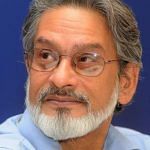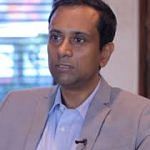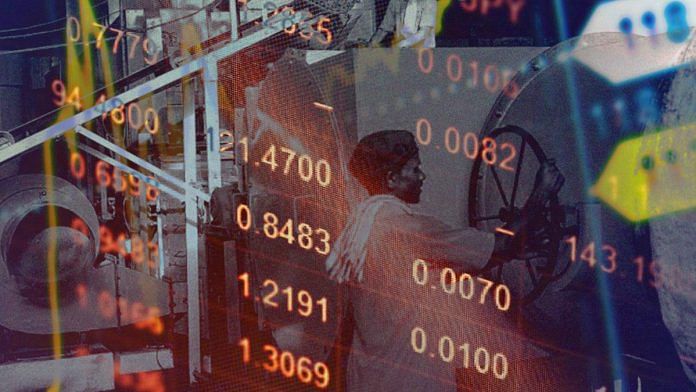Former chief economic advisor Arvind Subramanian has written that methodological changes led to overestimating the GDP growth by 2.5 percentage points per year between 2011-12 and 2016-17. In his article in The Indian Express, Subramanian said the actual growth was around 4.5 per cent as opposed to the official estimates of 7 per cent.
ThePrint asks: India’s slowdown: Blame faulty GDP data or should policymakers have used other indicators?
India’s GDP today measures only the performance of corporate sector, not the unorganised
 Pronab Sen
Pronab Sen
Former Chairman, National Statistical Commission
The slowdown we are seeing today is based on exactly the same methodology that was showing us high growth last year. You could question the high growth last year, but what you cannot question is that there is a slowdown this year.
When we talk about data, “correctness” can be of different kinds – one where we question if something is being measured correctly, and another where we question if we are measuring what we have really set out to measure.
India’s GDP today is based primarily on corporate data and so it really measures only the performance of corporate India. It does not measure the performance of the unorganised sector. Therefore, the GDP data (after looking at corporate balance sheets) was telling us that corporates were growing rapidly last year. The same methodology is now telling us that today, the corporates are slowing down. As long as we look at it that way, the data is fairly consistent.
We don’t have data of the unorganised sector, so we use data of the corporate sector as a proxy.
One has to understand the limitations of data — any data. Data is designed to measure certain things. Is it measuring corporate India accurately? The answer is yes. If we use this data to make policies about corporate India, it would probably be right. But if we use this data to make statements about the unorganised sector, that would probably be wrong.
Regardless of the exact percentage of GDP, the trend is quite clear: growth has been declining
 Devendra Pant
Devendra Pant
Chief Economist and Senior Director, India Ratings & Research
Modi govt may challenge older GDP estimates but the fact remains that all estimates show a downward slide
Robust data is a prerequisite for effective policy making and interventions, be it fiscal or monetary policy. For an individual, it is very difficult to quantify economic growth correctly, but what is important here is that even the GDP growth estimated by the government showed a consistent downward trajectory over the years.
Regardless of what the exact percentage of the GDP was, the trend is quite clear: GDP growth has been declining. So, ideally, policy action should have been based on that declining trend and not necessarily on the nitty gritty of what the exact GDP estimate was. The quarterly growth is at 20 quarters low, the annual growth too is at a 5-year-low. How can we negate that? Data is indeed important, and all data showed us that the state of the economy is not good and is consistently becoming worse off.
Let’s say the present government is right in challenging the older GDP estimates. The fact still remains that all estimates show a downward slide of the GDP. That itself is sufficient to say that we should have done something to stop this downward growth trajectory. We need to take stock of the situation and something needs to be done to salvage the economy.
Also read: A $13 billion fund still has faith in Indian consumer stocks, sees slowdown temporary
Comparing GDP numbers from two base years of 2004-05 and 2011-12 will be fraught with challenges
 Radhika Pandey
Radhika Pandey
Economist, NIPFP
The GDP numbers from the 2004-05 base year and the 2011-12 base year are not comparable and any attempt to compare GDP numbers from the two base years is fraught with challenges. In contrast to the earlier episodes of base year changes, the 2011-12 update was marked by changes to the methodology and data sources.
Regardless of the GDP debate, there are enough indications to suggest that the Indian economy is in the middle of a slowdown. The indicators that policy-makers usually rely on to make a statement about the state of the economy, and which are well-measured, are showing signs of moderation.
Agricultural growth is slowing. Consumption demand as measured by indicators such as sales of cars, two-wheelers and tractors etc is witnessing a slowdown. Non-oil, non-gold imports: a good proxy for demand in the economy is slowing. The NBFC sector is facing a liquidity crunch. Though possibly temporary, there are hard times for the aviation sector too. The recent pick-up in fixed investment is small and needs to be sustained. Policy measures are thus needed to reverse the slowdown. While the GDP provides a summary measure of the state of the economy, it is better to look at a wider set of variables representing agriculture, industry, services, trade etc to arrive at an assessment about the economy. At the same time, there is a need to comprehensively revisit the sources and methodology to arrive at credible GDP statistics.
Views are personal.
Also read: Budget awaits inputs from new cabinet panels on growth & unemployment
Policy making should rely on a number of indicators like jobs and consumption data, not just GDP
 Himanshu
Himanshu
Associate professor of Economics, JNU
The points raised by former chief economic advisor Arvind Subramanian have been raised by many people in the past, including the RBI. That there is enough reason to doubt the GDP calculation methods and GDP estimates has been a concern flagged by the IMF and other independent agencies as well. So, Arvind Subramanian’s article doesn’t quite come as a surprise.
Nonetheless, the point he is raising is very important. Policy making is of crucial importance and if the basic metrics on which the policy is based is flawed then the policy in itself is bound to be fallacious.
That said, the GDP is only one of the many indicators that one needs to keep in mind while making policy. It is wrong to rely solely on GDP numbers because GDP anyway is an outcome of a number of other things.
There are several other indicators that were telling us an entirely different story, such as unemployment data, consumption data, exports. Wage data was a very good indicator telling us what’s happening in rural India. So, we can’t blame the erroneous GDP data to say that policy failed because GDP data was inaccurate. That would be using GDP as a convenient excuse, when our policy is anyway supposed to rely on a variety of indicators.
Subramanian’s article throws light on the kind of dharma sankat economists face when in government
 Rajesh Chakrabarti
Rajesh Chakrabarti
Professor and Vice-Dean at the Jindal Global Business School, O.P. Jindal Global University
The GDP estimation in India is a complicated and imperfect exercise in the best of times. The “true picture” may forever remain elusive given the assumptions on the way. However, consistency of method is the way out of this quandary to give reasonable credibility to the growth rates observed.
Companies are known to manage earnings to avoid taxes. Democratic governments have become good at the game evidently. Former chief economic advisor Arvind Subramanian’s sobering revelations after the elections underline that timing is everything – not just in politics but also in economics.
The new methodology used to calculate GDP figures that had left former RBI governor Raghuram Rajan foxed and continues to confuse economic forecasters who now turn to sectoral indicators for guidance, painted a rosier picture about the Modi government’s first tenure. The admission of its overestimation now may make the slowdown look less ominous in the government’s new term.
This is a classic case of heads I win, tails you lose. Subramanian’s past research, with economist Dani Rodrik for instance, has uncovered interesting facts of India’s growth story. Today, Subramanian’s article throws ample light on the nature of many dharma sankat the economists face when in the government.
By Fatima Khan, journalist at ThePrint.




There is merrit existing beyond bureaucracy and it is a good idea to tap it.
Arvind has estimated proxy for GDP based on data of 17 transactional variables. Not to be surprised, he is getting different(lower) ‘GDP’ estimates. The issue really is which methodology should one adopt? Since the revised methodology worked on during UPA and NDA times is an accepted international methodology, we need to review it or we may supplement it with transactional or expenditure based GDP estimates. In any case, the issue is wide open. So long as it is not politicised as UPA versus NDA, it is fine. As regards Arvind’s observation that had it been known that growth rates are lower than published, Jaitley could worked on banking or agriculture reforms, is bizzare. These reforms were pending for years and should have been taken up immediately after his first budget. In fact, failure of Jaitley is precisely this. Modi relied heavily on Jaitley for economic affairs and he indeed let him down. Hope Modi gets this right in his second term.
Think of the two pilots who fly an A 380 or a 747. Thousands of pieces of data flashing before their eyes. The economic team does not have the same precision at work before it, but what it does share with them is the good judgment that comes from having flown tens of thousands of hours, some of it through scary weather and storms. 2. Meaning no disrespect, but the former CEA is being a little economical with the truth. If he did not know – and understand with far greater sophistication than the rest of us possess, basing our assessments on anecdotal evidence, apart from lived experiences – that the economy was stumbling, all the more after demonetisation – he was of use to the government only for the pretty, well annotated Economic Survey he brought out. 3. One sees no contradiction – beyond a healthy creative tension – between world class economists like Dr Rajan, mandarins in the Ministry of Finance – among the brightest members of the civil service , as is the case all over the world – and the political executive which understands the development imperatives of a largely poor / lower middle class country. They have all the information they need to craft sound economic policies. They also have access to the collective wisdom and advice of the business community, spanning the expanse from India Inc to small traders and businessmen who have always supported the ruling party.